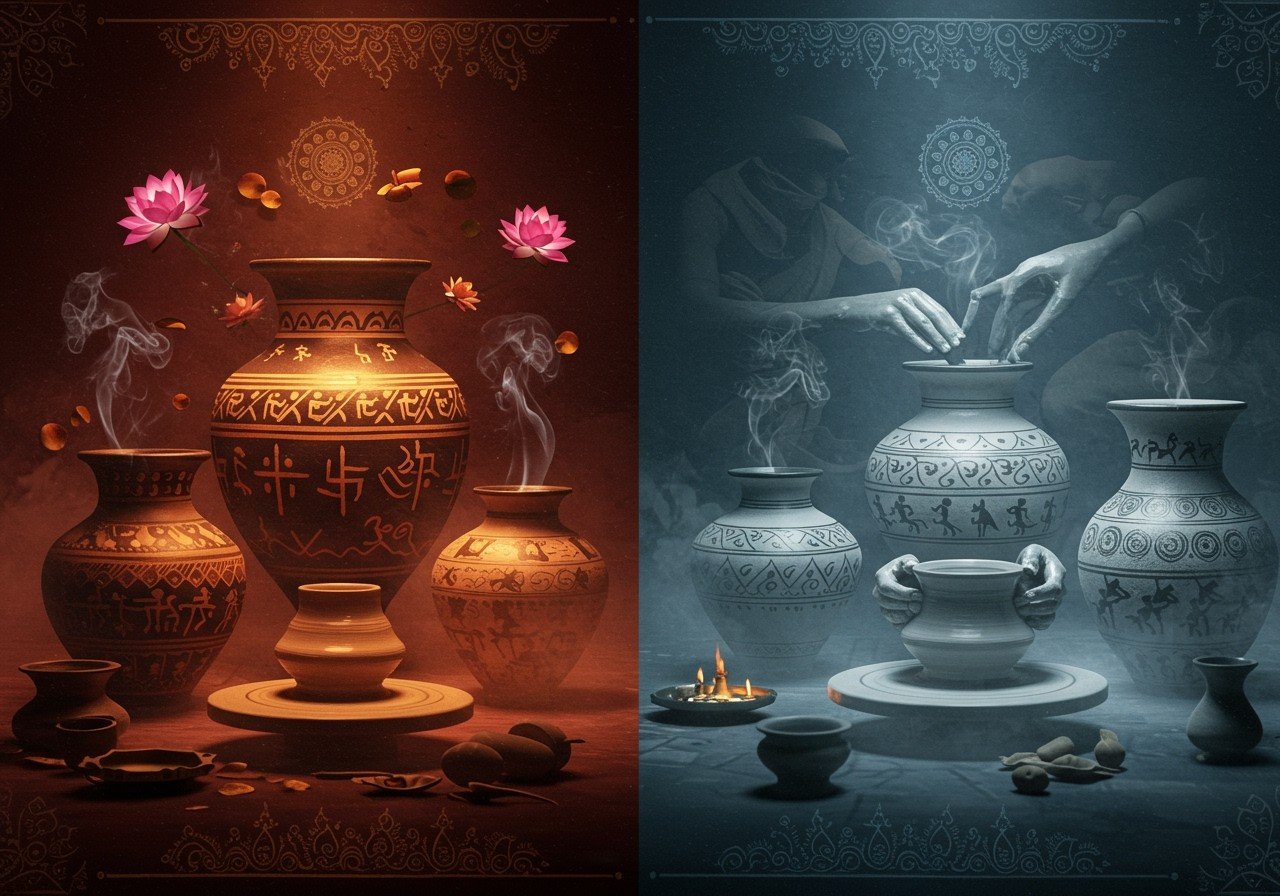
Ancient Indian pottery offers a captivating glimpse into the subcontinent’s rich cultural and historical tapestry. From early settlements like Lahuradewa and Mehrgarh, dating back to the Indus Valley Civilization around 2500 BCE, pottery has played a significant role in Indian culture. This article delves into two prominent pottery styles: Black and Red Ware (BRW) and Painted Grey Ware (PGW), illustrating their evolution, significance, and the insights they provide into ancient Indian civilizations.
Black and Red Ware (BRW)
Characteristics and Techniques
BRW pottery stands out with its distinctive two-tone color scheme. The interior and lower portion typically display a rich black, while the exterior and upper part exhibit a vibrant red. This unique effect, achieved through specialized firing techniques involving oxidizing and reducing atmospheres, emerged around 1200 BCE and continued until 800 BCE, overlapping with the later Vedic period.
Shapes and Sizes
BRW pottery encompasses a wide array of forms and dimensions, including bowls, dishes, and jars. These vessels served both everyday domestic purposes and played a role in ritualistic activities, highlighting their versatility in ancient Indian life.
Geographic Spread
BRW pottery is predominantly discovered in northern and central India, with key archaeological sites like Hastinapur and Rajghat yielding significant finds. These discoveries underscore the style’s prevalence in these regions during its period of prominence.
Materials and Decoration
Crafted from fine clay, BRW pottery often features incised patterns, adding an element of artistic expression to these functional objects. These decorative elements enhance their aesthetic appeal and offer glimpses into the cultural significance they held.
Socio-Economic Implications
The production of BRW pottery signifies a sophisticated level of craftsmanship and established trade networks. This reflects the socio-economic conditions of the time, suggesting a level of societal organization and specialized skills in pottery production and distribution.
Painted Grey Ware (PGW)
Characteristics and Techniques
PGW pottery is recognized for its elegant grey color and intricate painted designs, often executed in black. Emerging around 1100 BCE and lasting until 400 BCE, partially coinciding with the later Vedic period, its characteristic grey hue is achieved through controlled firing processes, demonstrating advanced pyrotechnological knowledge.
Shapes and Sizes
PGW pottery includes a variety of shapes, such as bowls, dishes, and storage jars. While primarily used for domestic purposes, these vessels also played a role in burial practices, offering insights into ancient funerary rites and beliefs.
Geographic Spread
PGW pottery is primarily found in the Ganges Valley and Northern India. Significant discoveries at archaeological sites like Ahichhatra and Atranjikhera highlight its prevalence in these regions during the late Vedic period.
Materials and Decoration
Made from fine clay, PGW pottery showcases decorative motifs, including geometric and floral designs. These painted patterns enhance the pottery’s aesthetic value and provide clues about the artistic sensibilities and cultural symbolism of the time.
Socio-Economic Implications
The production of PGW pottery points towards a highly organized community with well-established trade connections, reflecting the socio-economic dynamics of the era and suggesting specialized production centers and distribution networks.
Comparing BRW and PGW
Technological Aspects
BRW pottery utilizes oxidizing and reducing atmospheres during firing to achieve its distinctive black and red coloration. In contrast, PGW pottery employs controlled firing processes to attain its characteristic grey hue, demonstrating different approaches to pyrotechnology.
Decorative Elements
BRW pottery often features incised patterns, showcasing a distinct decorative style. PGW pottery, on the other hand, is known for its painted designs, often featuring geometric and floral motifs, revealing diverse artistic traditions.
Geographic Distribution
BRW is primarily found in northern and central India, while PGW is prevalent in the Ganges Valley and Northern India. This suggests distinct centers of production and potentially different cultural spheres of influence.
Chronological Development
BRW emerged around 1200 BCE and lasted until 800 BCE, coinciding with the later Vedic period. PGW also appeared during the later Vedic period, around 1100 BCE, and continued until 400 BCE, indicating some overlap in their timelines.
Usage
BRW pottery served both daily domestic needs and ritualistic purposes, reflecting its versatility in ancient Indian society. PGW pottery, while mainly used domestically, also played a role in burial practices, offering insights into ancient funerary customs.
Poojn.in: Connecting You to India’s Pottery Heritage
At Poojn.in, we bridge the gap between ancient pottery traditions and modern living. Our collection of premium clay dinner sets echoes the artistry of historical pottery styles like BRW and PGW, bringing a touch of India’s rich cultural heritage to your dining table.
- Premium Clay Construction: Our dinner sets are crafted from high-quality fired clay, using techniques reminiscent of traditional pottery making.
- Hand-painted Designs: Each piece is adorned with intricate hand-painted designs using vibrant Camlin Fabrica acrylic colors, adding a touch of artistic flair.
- Complete Dining Experience: Our sets include 12-inch plates, bowls, and glasses, providing a comprehensive dining solution.
- Secure Delivery: We ensure safe and secure packaging for nationwide delivery across India.
- Unique Red Hues: Our dinner sets are available in striking red hues with intricate hand-printed patterns, adding a touch of traditional elegance.
Each set is handcrafted by skilled artisans, making every piece unique. Explore our exclusive collection of clay pots and dinnerware at Poojn.in, India’s largest Dashakarma bhandar, and experience the authenticity of ancient pottery traditions with modern convenience.
Conclusion
Both Black and Red Ware (BRW) and Painted Grey Ware (PGW) offer invaluable insights into the rich cultural heritage of ancient India. These pottery styles showcase not only technological advancements but also artistic expression and socio-economic conditions of their respective periods. Studying these styles allows us to appreciate the craftsmanship of our ancestors and connect with the traditions that continue to shape our cultural identity.


